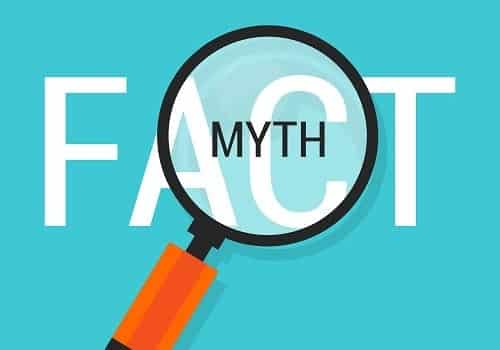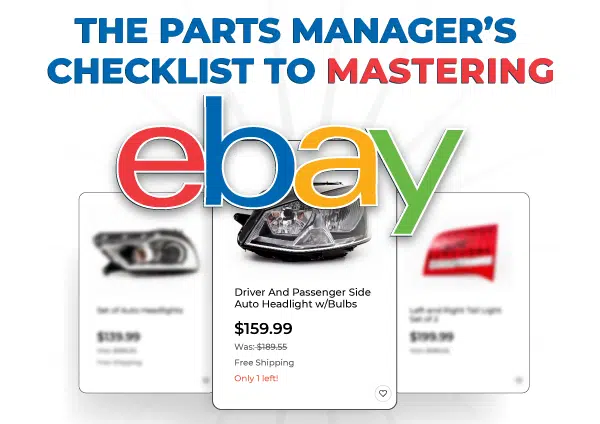If you believe everything you hear, selling auto parts online might sound like too much hassle for the low-margin sales you get in return.
In reality, many of the problematic things you’ve heard are nothing but myths. We want to clear the air about a lot of these myths, since there simply isn’t much grounding in truth.
Selling online takes some effort, sure, but it’s far from impossible and it’ll be worth the investment. So what myths are keeping you from starting your parts store, and why aren’t they anything to worry about?
Myth #1: Just build a website, and customers will come.
Unfortunately, the internet is just too large for shoppers to find you by chance.
You MUST invest in some kind of marketing in order to get your name out there. Whether you try your hand at DIY marketing or hire a marketing agency to do it for you, you have to do something.
With so many potential customers at their keyboards and ready to buy, how can you be the first one to attract that customer’s attention?
Answer: marketing.
We recommend marketing with Google search ads Read more about that here. You do NOT have to do this yourself. Hire a marketing agency to handle it for you.
In addition, it’s really easy to build an email list and draw in customers with promotional emails every time you have a sales event.
There’s plenty more you can do, but those two are a great start.
What about a Marketing Agency?
If you don’t have an internal marketing team, we strongly recommend working with a marketing agency. Agencies are full of trained professionals that can get you a worthwhile return on investment, so they’re worth the added cost.
To learn more about what an agency does and how they can help, check out this article: Top 7 FAQs about Digital Marketing.
Myth #2: You have to be tech-savvy to succeed.
At a glance, the idea of selling parts online looks like a headache.
There’s talk of servers, domain names, payment gateways, pricing matrixes, and more… on top of all the marketing jargon you hear about!
Many people believe you need previous knowledge and experience to sell parts online. It helps, but remember that you’re not alone. If you choose a reliable vendor, they’ll guide you through every step of the way.
RELATED: How to Choose the Right eCommerce Platform to Sell Auto Parts Online
At RevolutionParts, we handle the technical details like building your website. If you do get a little lost, help is only a phone call away.
Once the parts website is set up, your solution should also train you on how to get the most out of the software and advise you on best practices.
RevolutionParts customers get a dedicated Dealer Advisor to reach out to, in addition to countless tutorials and video guides on our Knowledge Base.
And, of course, we have the resource center where you’re reading this right now!
Myth #3: You will upset local customers if you sell online.
Due to online competition, your web store has to have lower prices than your parts counter. So a lot of dealers ask, “Won’t that upset local customers who notice the lower prices online?”
It’s actually not something you need to worry about. Here are a few ways to avoid that issue…
Solution 1: Sell on your dealership website.
Instead of selling on a standalone website, RevolutionParts offers store plug-ins that simply embed on your existing dealership site. It can replace the parts request form on your dealership website with a parts catalog and shopping cart, with everything priced the same as in-store.
Visitors already browse your dealership site, and the store plug-in is easier to use than the parts request form.
Solution 2: Sell under a pseudonym.
When it comes to selling nationally on your own website or on eBay Motors, many dealerships choose to sell under a new name. Instead of “Sunny Bay Toyota,” you can sell under a more generic name like “OEM Toyota Parts Warehouse.”
That way, your website isn’t associated with your dealership and you can change up prices however you’d like.
Price-conscious online shoppers already know they can get better deals by researching online, so you aren’t sacrificing margins by selling nationally.
Solution 3: Just don’t worry about it.
Honestly, most customers won’t even notice that the price is lower online. Of those who do notice, they won’t be surprised—they know online prices tend to be lower than in-store. If anything, they’ll be happy to have stumbled across a surprise discount from your dealership.
The fact that they were searching online means they were already hunting for a better price. Wouldn’t you rather the sale goes to you than one of your competitors?
It may be worth less than an in-store sale, but some dealerships would argue that it’s better than nothing at all.
Check out this article for more tips on how to handle this situation.
Myth #4: Selling parts online is too price-competitive to be profitable.
You can’t sell parts at list price and expect to get many sales. Selling online requires a different strategy than what you’re used to in-store, but it’s certainly still profitable if you play it right.
Sell at Cost +
Most online stores opt to sell at Cost + %. The best percentage will vary a lot by part category, brand, and so on, so it may take some trial and error to find the pricing sweet spot. We recommend setting up a pricing matrix to help you get there.
With the right strategy, selling online IS profitable.
Dealer success ranges drastically, but the average dealer with RevolutionParts makes around $20k-$30k in sales every month. Our top stores easily sell over $1 MILLION in parts every single month.
The right software and strategy can even help your team compete with aftermarket parts, which opens up the opportunity even more.
Find Your Strategy
Most of the time, selling online is a volume game. Focus on fast-moving parts, and be smart about excluding certain categories of parts based on price point and margins.
You will also need to differentiate on speed and service to be as competitive as possible. Plus, when you hit certain sales volumes, you might be able to earn manufacturer incentives depending on your business.
Remember: YOU get to choose which parts you sell.
If certain parts aren’t profitable, then don’t sell them. Simple as that. Hazmat parts or oversized items like bumpers, for example, are often just not worth it.
Myth #5: Offering a dirt-cheap price is the only way to attract customers.
Yes, having a competitive price helps. But you don’t have to have the lowest price on the internet in order to make sales.
Factors like customer service and shipping speed can make a big difference, too.
Customer Service
If a shopper has a question about a part before they buy, they’ll want to ask you before purchasing. Customers don’t like dealing with returns any more than you do.
If they call the website with the lowest price and no one answers, then they might not buy there! Lowest price doesn’t mean everything.
Establish yourself as a credible and reliable source for info, and shoppers will know they can count on you.
Shipping
Don’t worry about competing with Amazon’s 2-day free shipping. But letting orders stack up for DAYS won’t win you happy customers.
Fulfill and ship out orders as soon as possible—ideally within 1 business day.
RELATED: 5 Customer Service Fails that are Driving Away Customers
Myth #6: The internet is teeming with scams and hackers. The risk of fraud just isn’t worth it.
Yes, there are hackers out there. Yes, you will come across fraud.
But these days, you’ll be equipped with tools that recognize and identify fraud before it hurts your business.
The built-in fraud indicator on RevolutionParts runs over a dozen tests on each order. Each risky order will be flagged, and you can simply cancel it.
Here’s an example of what the fraud warning looks like. As you can see, the system will list exactly why an order is raising red flags so you can make an educated decision to either fulfill or cancel it.
PCI compliant systems like RevolutionParts are secure and tokenize sensitive information. Even if a hacker does manage to get in, they won’t find anything to steal.
RELATED: Top 10 Red Flags for Online Fraud on your Parts Website
This isn’t to say selling online is free, easy money. You’ll still have to put in some time and effort, as well as investing in marketing and learning best practices. But it’s not nearly as difficult as you might think.
Don’t let the myths you’ve heard scare you away from starting an online business with great potential for success. With the support of a great eCommerce provider, a profitable parts website is in reach for any dealership willing to try.







